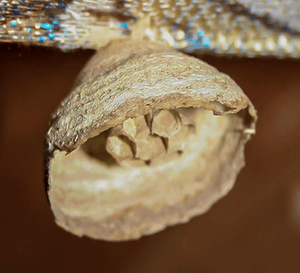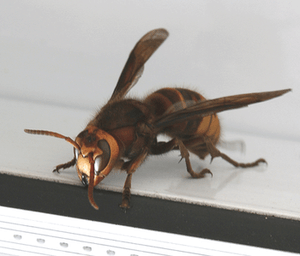Questions answered about wasps - Page:7
I have found a small wasp nest; if I remove it will the queen rebuild it?
If you destroy a small wasp nest (golf ball size with just the queen present) and do not kill the queen, she will typically move to a different location and start a new nest.
Some worker wasps will be present as nests become older and more established. Destroying just the nest does not always work; they rebuild in the same position. To be successful, you will also need to kill the worker wasps.

What does a hornet look like?
A European hornet looks very similar to a normal wasp, just more significant with a rusty brown sheen.
Take a look at some of the pictures we have on our site.

Wasp stopped building its nest, why?
When queen wasps start building their nests, no worker wasps are present. The queen must undertake every daily task, including collecting nest-building materials, finding food for herself, and hunting for her young larvae. At this time, she is very vulnerable to other predators.
Birds often catch and eat queen wasps; other insects also predate on them. As the queen is the only wasp capable of laying eggs, if she gets killed, her nest cannot progress further. If a worker wasp gets killed, it is insignificant to the survival of the nest.
Do wasp traps work?
Wasp traps are not an alternative to having a nest treated.
If you have a wasp nest and you want it gone, you will need to have the nest killed.
Wasp traps have some degree of success if wasps are a problem in gardens and the nest cannot be found.
A well-placed trap can reduce numbers if a nest is close but not on your property.
The dome-type traps, which you can buy for a few pounds, are not the answer; these traps worsen the problem as they allow a percentage of wasps to escape and communicate to their nest the location of the food source within the trap.
High-efficiency wasp traps are the best type.
How often do wasps reproduce?
The queen wasp is the only wasp in the nest which lays eggs. The queen produces all of the worker wasps (all sterile females).
So, in essence, the queen wasp reproduces throughout the summer, laying new eggs each day.
In the autumn, the queen lays a batch of special eggs, the last eggs she will produce.
These eggs will become new queens and male (drone) wasps.
These new queens and males leave the nest to mate. Once mated, the males die, and the new queens find somewhere to hibernate over winter ready for the following year. The original queen and all the worker wasps gradually die off as the food supply runs out in winter.
